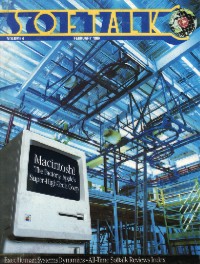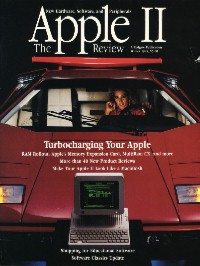
My appleII Notes-3
My AppleII Notes-3
99/5/22 AppleII Magazines from the USA

Here are my recently acquired Apple
II related magazines. From the top left, Byte (1978), Kilobaud Microcomputing
(1979), Softalk (1983-1984), Personal Computing (1984-1985), II Computing
(1986-1987), Apple Orchard (1983), Core (1983), The Apple II Review (1985-1986),
Apple II GS The Buyer 's Guide (1988 - 1990).
When I looked at the magazines on the
table, I guessed that, although little information came in Japan, the Apple II
in the 1980s was received with great enthusiasm in the United States, especially
after the release of the Macintosh in 1984.
Reading old magazines is one of my
pleasures, but the first thing I look out for is advertising by Apple computers.
Especially in the first half of the 1980's, different machines that varied in
performance were released and the models were geared towards different users -
one almost every year, i.e., the Apple III, Apple IIe, Lisa, Macintosh, and
Apple IIc. Taking a look at the magazine advertisements, we can learn about the
characteristics of these machines and Apple Computer’s PR strategy.
For example, it is interesting that,
during in the August 1984 issue of Personal Computing magazine, an advertisement
of the Apple IIc appeared in an 8 page spread in full color on fine paper.
However, at the same time, Apple didn’t go to great lengths to advertise in the
Softalk or Nibble magazines, and if anything only to advertise software or
peripheral devices in plain format once every so often. In response to growing
competition from IBM PCjr and to attract new Apple IIc users, it seems that
Apple Computer concentrated on the power of advertising in the Personal
Computing magazine.
It seems that two types of magazines
in the 1970s, Byte and Kilobaud Microcomputing, ushered in a new personal
computing century. Early advertisements and articles that feature the original
Apple II etc. can be found in these magazines. I'd like to introduce these kinds
of magazines on this Website.
First of all, I’ll introduce two
magazines that I picked up.
 |
SOFTALK With a beautiful female editor-in-chief Margot Comstock Tommervic, Softalk magazine was first published in September 1980, and while based in California, many of its readers appear to be business people from areas such as Boston, New York and Chicago on the east coast. The photo on the left is of the February 1984 issue. In an article called "Mac Factory! Apple's Highest-Tech Assembler", along with a Macintosh article announced in the previous month, a new Macintosh manufacturing factory is introduced with a multitude of photographs and illustrations.
According
to this article, from around this time about two years previously (1982)
Steve Jobs and Bob Belleville visited Japan to
observe the Japanese manufacturing system. They visited Toyota, Yamaha,
Panasonic and Hitachi. It is said that they learned about the Japanese
manufacturing system, manufacturing automation, and the management system,
etc. and that they used these models to design the factory production line
as seen on the front cover of this magazine.
|
 |
THE APPLE II REVIEW
Almost all
pages of the Apple II Hardware and Software Buyer’s Guide are color
pictures. In the 1985 Winter issue, although the articles consist of
relatively ordinary product introductions, these can help us learn about
product trends at the time, mainly concerning peripheral devices and
software of the Apple IIc.
|
99/5/16 Repair of DiskII
 |
This Disk II
arrived the other day, both of the plastic door hinges of the front door
assembly were broken. The front door must have opened due to some vibration
during transportation, and it seems that it was exposed to excessive stress
from a horizontal direction. I have several Disk IIs, so it is not troubling
for the time being, but I felt bad because it still remained broken. So I
searched for the parts to fix it. On the Internet, although the parts are
listed on the Sun Remarketing Web Site (about US $ 13), there were none in
stock and I would have to have waited for them to get more in. I wasn’t sure
how long this would take, so I decided to look for parts in Akihabara. By
chance, “Akihabara Electric Parts” had a ready assembled item, without a
connecting cable, for 1,000 yen in a junk basket, so we bought it and could
repair the broken one. I am very fortunate to be living so close to
Electric Town in Akihabara, Tokyo. |
Procurement of parts from shops
overseas is often very expensive especially when including transportation costs,
so when you find suitable junk items in Akihabara it is a good idea to buy them
and stock them as spare parts.

I opened up two Disk IIs and compared
the analog base of the initial one and the latter one side by side. The green
board visible in the center is an analog board. The left is the initial one, the
right is a latter one. For the initial one, there is a square hole in the center
of the base indicating that it might have been used for head testing. Also, on
the lower right signal cable of the latter one, there is a guide to prevent
cable from coming adrift. In the initial one, this connector may have fallen off
during transportation, etc. and this may have been why it didn’t not recognize
the disk. The front door assembly that was repaired this time also had a very
delicate designed, as durability of the plastic was of an earlier type.
Following feedback from this, it appears that Apple’s engineers remedied this
problem and improved the design of the product.
"
How To Repair And Maintain Your Apple Computer" in (Author,
Gene B.Williams), the adjustment method of Disk II is described in very
carefully Photo, I become feeling like most of the trouble can be repaired.